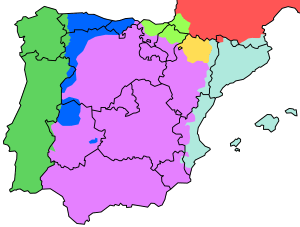West Iberian languages facts for kids
Quick facts for kids West Iberian |
|
|---|---|
| Western Iberian Romance | |
| Geographic distribution: |
Iberian Peninsula, Latin America, Africa, Israel, Philippines, East Timor, Easter Island, Goa |
| Linguistic classification: | Indo-European
|
| Subdivisions: |
Astur-Leonese
Barranquian
Pyrenean–Mozarabic
|
 Languages of the Iberian Peninsula
West Iberian: Aragonese Astur-Leonese Barranquian Extremaduran Fala Galician Portuguese Spanish-Castillian Occitano-Romance: Catalan Occitan Others: Basque (non-Romance language isolate) |
|
The West Iberian languages are a group of languages that grew from Latin in the western and central parts of the Iberian Peninsula. This area includes countries like Spain and Portugal. The two most widely spoken languages in this group are Spanish and Portuguese.
These languages spread to many parts of the world, especially Latin America, during the colonial era. There are five main branches of West Iberian languages. These include Castilian, Galician-Portuguese, Astur-Leonese, Barranquian, and Pyrenean–Mozarabic. Long ago, people speaking these languages could mostly understand each other. Today, they have changed so much that it is harder for speakers of different branches to communicate easily.
Contents
What are Language Families?
Think of languages like a big family tree. A "language family" is a group of languages that all came from a single older language. For example, the West Iberian languages are part of the larger Romance family. All Romance languages, including French and Italian, grew from Latin. Latin was the language spoken by the ancient Romans.
How Languages Change Over Time
Languages are always changing, just like people. Over hundreds of years, words and grammar slowly shift. When groups of people speaking the same language move to different places, their language can change in different ways. This is how new languages are born from an older one. The West Iberian languages are a great example of this process.
Where are West Iberian Languages Spoken?
The West Iberian languages started in the Iberian Peninsula. This is the land where Spain and Portugal are located today. But they didn't stay there! When explorers and settlers from Spain and Portugal traveled the world, they brought their languages with them.
Global Reach of Spanish
Spanish is now spoken by hundreds of millions of people. It is the official language in many countries across Latin America. You can also find Spanish speakers in parts of the United States, Africa, and even the Philippines. It is one of the most widely spoken languages in the world.
Global Reach of Portuguese
Portuguese is also a very important global language. It is the official language of Portugal and Brazil. Brazil is the largest country in South America. Portuguese is also spoken in several countries in Africa, such as Angola and Mozambique. You can also find Portuguese speakers in places like Goa in India and East Timor.
Main West Iberian Languages
While Spanish and Portuguese are the biggest, there are other important languages in this family. Each has its own unique history and culture.
Castilian (Spanish)
Castilian is the official name for the Spanish language. It started in the Castile region of Spain. Over time, it became the main language of Spain and then spread across the world. It is known for its clear pronunciation and rich vocabulary.
Galician-Portuguese
This branch includes Galician and Portuguese. They both developed from a common language spoken in the northwest of the Iberian Peninsula. Galician is spoken in the Galicia region of Spain. It is very similar to Portuguese, and speakers of both languages can often understand each other.
Astur-Leonese
Astur-Leonese is a group of languages spoken in parts of northern Spain and Portugal. It includes languages like Asturian and Leonese. These languages have their own unique features and are important parts of the local culture.
Barranquian
Barranquian is a special language spoken in a small town called Barrancos in Portugal. It is interesting because it mixes features of both Portuguese and Spanish. This shows how languages can blend when different groups of people live close together.
Pyrenean–Mozarabic
This branch includes languages that were once spoken in different parts of the Iberian Peninsula. Mozarabic was spoken by Christians living under Muslim rule in southern Spain. These languages are mostly not spoken anymore, but they are important for understanding the history of the West Iberian language family.
See also
 In Spanish: Lenguas iberorromances occidentales para niños
In Spanish: Lenguas iberorromances occidentales para niños

